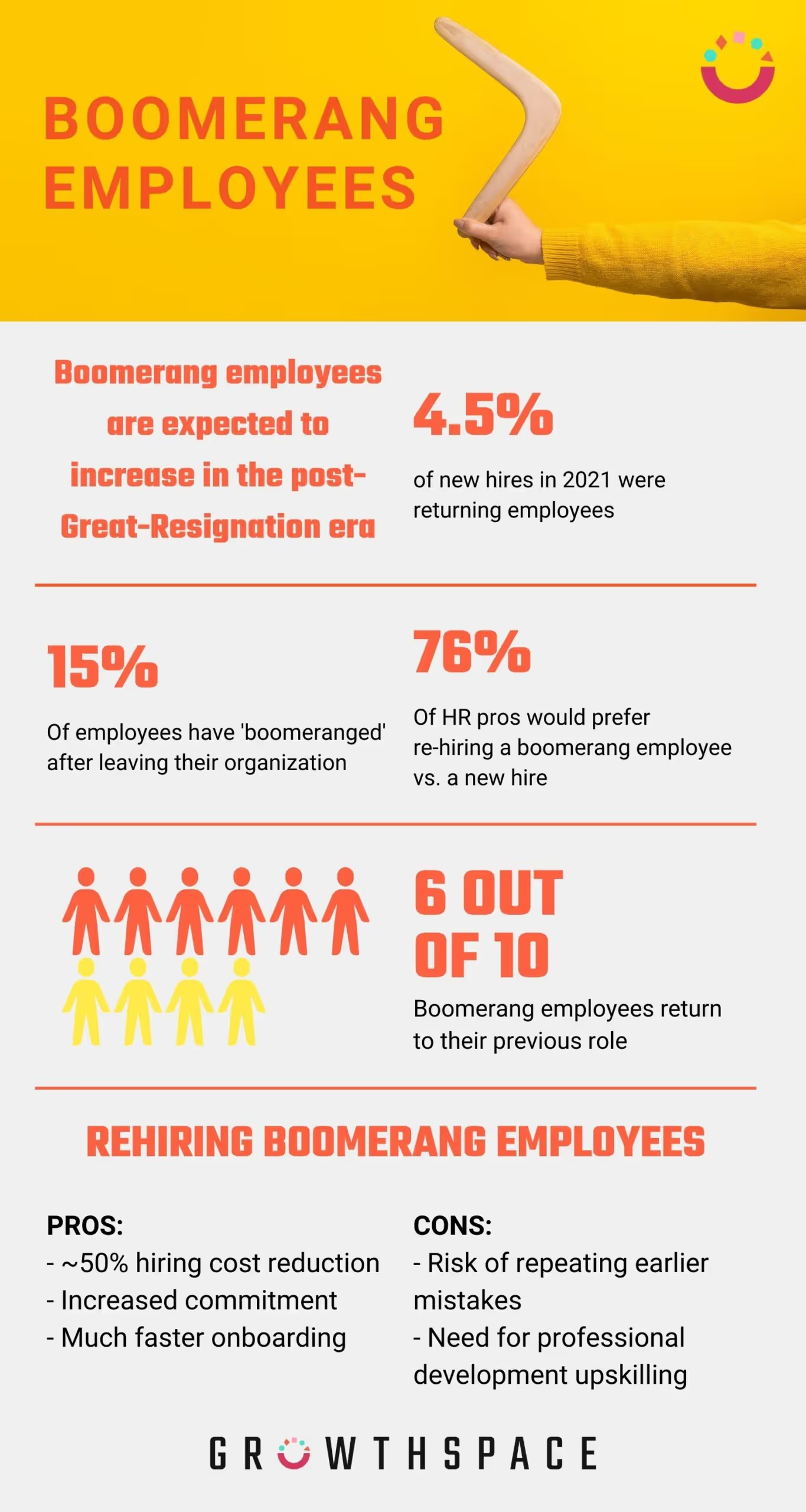Boomerang Employees
Boomerang employees bring plenty of advantages–and certain strings. They know the product and have already acclimatized to the culture. However, taking a hiatus in today’s market means they’ll need L&D programs to get up to speed.
What Is a Boomerang Employee?
Boomerang employees (AKA boomerang workers) are those who were previously employed by an organization, left for some reason, and were then rehired.
Their reason for leaving their job, and the manner by which the worker quit, will naturally have an effect on their chances of being hired again. For example, employees who take maternity leave, pursue an academic degree, or are pulled away by a responsibility (military service, caring for a loved one) are some of the most likely to be rehired. Similarly, employees who depart in a respectable manner have better prospects than those who refuse to return property, won’t participate in interviews, and are rude to staff when they leave the company.
Boomerang Employee Statistics
It was predicted that boomerang hiring would increase in the wake of the Great Resignation. We already see this trend rising, as 4.5% of new hires in 2021 were composed of returning employees, compared to 3.9% in 2019. In addition:
- 15% of employees have boomeranged
- 76% of HR professionals are more interested in boomerang hires than previously
- 73% of managers have a neutral or positive view of hiring former employees
Overall, these numbers show that the majority of staffers with hiring authority seem open to boomerang employees.

The Advantages and Disadvantages of Boomerang Hiring
Advantages
Lower hiring expenses
Hiring a former employee saves recruitment costs, particularly when they are part of upper hierarchies. The expense of the process of interviewing, testing, and background checks is greatly reduced, if not eliminated. It is estimated that boomerang hiring saves approximately 50% of related costs.
Superior performance
In comparison to external, recent hires, boomerang employees demonstrate increased satisfaction and commitment. This makes sense considering that these workers understand the environment outside of their former company, and probably realize that it is better to return to their former job. In fact, ex-employees tend to be more productive and stay longer at the organization (the second time around). Having discovered first-hand the pros and cons of their employer when they were out in “the real world”, boomerang employees also motivate coworkers who may have thought of leaving. The HR department can also learn from their experience, and discern the factors that make the company attractive to the hiring market.
Rapid acclimatization
Unless they have been absent for a long time, returning workers are already familiar with the hierarchy, the way the organization functions, and the company culture. They will have more reasonable expectations than new hires, who can be disappointed when their new job does not match their assumptions. Boomerang employees, then, get up to speed more rapidly than a new worker, especially if they’re returning to their old role – which they do 63% of the time. All this being said–it is still important to properly re-onboard boomerang employees. Even though the employee has already been through the onboarding process their first time around, treating them as a ‘new’ employee will let them understand that coming back will be different this time around – and may even find additional motivation in view of these changes.
Disadvantages
Risk of repetition
Not every departing employee leaves their job due to a situation that the organization can fix. For example, if somebody departs because they don’t like their manager, but returns because they don’t like their new job either, then the aggravating factor still exists. In addition, if the organization has changed since the worker’s departure, they may not like the new direction. It is therefore essential for the boomerang employee to explain what will be different this time around, and why the reason for their previous departure is no longer relevant.
L&D requirements
Even an employee who has been away for only a few months can require reskilling or upskilling. At today’s pace of changing demand for certain skills, it is likely that the rehire is not up to date. A boomerang employee may have forgotten some of the finer points of their job, or the organization may have undergone a change that requires a skill update.
Use GrowthSpace for L&D of All Employees
Whether an employee is brand new, returning, or career employees, each can benefit from the learning and development efficiencies provided by GrowthSpace. The technology identifies skill gaps for thousands of employees, and provides customized matches to the top experts in their particular field. Ensure the success of your staffers–at all levels–with the GrowthSpace platform.














